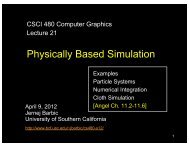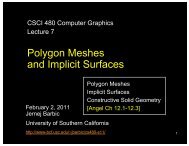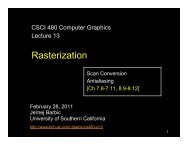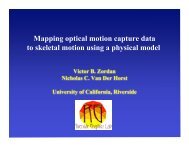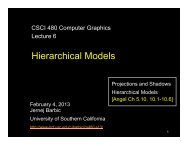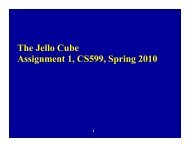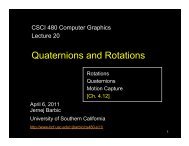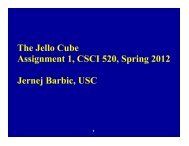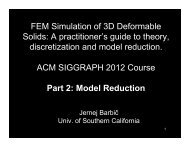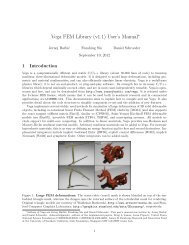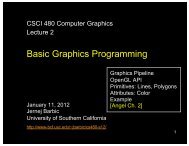Ray Tracing - University of Southern California
Ray Tracing - University of Southern California
Ray Tracing - University of Southern California
Create successful ePaper yourself
Turn your PDF publications into a flip-book with our unique Google optimized e-Paper software.
CSCI 480 Computer Graphics<br />
Lecture 15<br />
<strong>Ray</strong> <strong>Tracing</strong><br />
Mar 25, 2013<br />
Jernej Barbic<br />
<strong>University</strong> <strong>of</strong> <strong>Southern</strong> <strong>California</strong><br />
http://www-bcf.usc.edu/~jbarbic/cs480-s13/<br />
<strong>Ray</strong> Casting<br />
Shadow <strong>Ray</strong>s<br />
Reflection and Transmission<br />
[Ch. 13.2 - 13.3]<br />
1
Local Illumination<br />
• Object illuminations are independent<br />
• No light scattering between objects<br />
• No real shadows, reflection, transmission<br />
• OpenGL pipeline uses this<br />
2
Global Illumination<br />
• <strong>Ray</strong> tracing (highlights, reflection, transmission)<br />
• Radiosity (surface interreflections)<br />
• Photon mapping<br />
• Precomputed Radiance Transfer (PRT)<br />
3
Object Space:<br />
• Graphics pipeline: for each object, render<br />
– Efficient pipeline architecture, real-time<br />
– Difficulty: object interactions (shadows, reflections, etc.)<br />
Image Space:<br />
• <strong>Ray</strong> tracing: for each pixel, determine color<br />
– Pixel-level parallelism<br />
– Difficulty: very intensive computation, usually <strong>of</strong>f-line<br />
4
First idea: Forward <strong>Ray</strong> <strong>Tracing</strong><br />
• Shoot (many) light rays from each light source<br />
• <strong>Ray</strong>s bounce <strong>of</strong>f the objects<br />
• Simulates paths <strong>of</strong> photons<br />
• Problem: many rays will<br />
miss camera and not<br />
contribute to image!<br />
• This algorithm is not<br />
practical<br />
5
Backward <strong>Ray</strong> <strong>Tracing</strong><br />
• Shoot one ray from camera<br />
through each pixel in image plane<br />
6
Generating <strong>Ray</strong>s<br />
• Camera is at (0,0,0) and points<br />
in the negative z-direction<br />
• Must determine coordinates <strong>of</strong><br />
image corners in 3D<br />
7
z<br />
Generating <strong>Ray</strong>s<br />
y<br />
x<br />
center <strong>of</strong><br />
projection<br />
(COP)<br />
field <strong>of</strong><br />
view angle<br />
(fov)<br />
side view<br />
image<br />
plane<br />
ray<br />
h<br />
aspect ratio = w / h<br />
w<br />
z<br />
y<br />
frontal view<br />
8<br />
x
z<br />
COP<br />
Generating <strong>Ray</strong>s<br />
y<br />
x<br />
field <strong>of</strong><br />
view angle<br />
(fov)<br />
side view<br />
image<br />
plane<br />
z<br />
y<br />
x<br />
f = 1<br />
side view<br />
y = tan(fov/2)<br />
z = -1<br />
image<br />
plane<br />
y = -tan(fov/2)<br />
z = -1<br />
9
z<br />
Generating <strong>Ray</strong>s<br />
y<br />
x<br />
x = -a tan(fov/2)<br />
y = tan(fov/2)<br />
z = -1<br />
x = -a tan(fov/2)<br />
y = -tan(fov/2)<br />
z = -1<br />
h<br />
a = aspect ratio = w / h<br />
w<br />
frontal view<br />
x = a tan(fov/2)<br />
y = tan(fov/2)<br />
z = -1<br />
x = a tan(fov/2)<br />
y = -tan(fov/2)<br />
z = -1<br />
10
Determining Pixel Color<br />
1. Phong model (local as before)<br />
2. Shadow rays<br />
3. Specular reflection<br />
4. Specular transmission<br />
Steps (3) and (4) require<br />
recursion.<br />
11
Shadow <strong>Ray</strong>s<br />
• Determine if light “really”<br />
hits surface point<br />
• Cast shadow ray from<br />
surface point to each light<br />
• If shadow ray hits<br />
opaque object, no<br />
contribution from<br />
that light<br />
• This is essentially<br />
improved diffuse<br />
reflection<br />
light source<br />
scene<br />
object 2<br />
shadow ray<br />
(blocked)<br />
n<br />
ray<br />
camera<br />
image<br />
plane<br />
scene<br />
object 1<br />
12
Phong Model<br />
• If shadow ray<br />
can reach<br />
to the light,<br />
apply a standard<br />
Phong model<br />
light source<br />
shadow ray<br />
(unblocked)<br />
n<br />
l<br />
ray<br />
camera<br />
v<br />
scene<br />
object<br />
image<br />
plane<br />
13
Where is Phong model applied<br />
in this example?<br />
Which shadow rays are blocked?<br />
14
Reflection <strong>Ray</strong>s<br />
• For specular component <strong>of</strong> illumination<br />
• Compute reflection ray (recall: backward!)<br />
• Call ray tracer recursively to determine color<br />
15
Angle <strong>of</strong> Reflection<br />
• Recall: incoming angle = outgoing angle<br />
• r = 2(l • n) n – l<br />
• Compute only for surfaces<br />
that are reflective<br />
16
Reflections Example<br />
www.yafaray.org<br />
17
Transmission <strong>Ray</strong>s<br />
• Calculate light transmitted through surfaces<br />
• Example: water, glass<br />
• Compute transmission ray<br />
• Call ray tracer recursively to determine color<br />
18
Transmitted Light<br />
• Index <strong>of</strong> refraction is speed <strong>of</strong> light,<br />
relative to speed <strong>of</strong> light in vacuum<br />
– Vacuum: 1.0 (per definition)<br />
– Air: 1.000277 (approximate to 1.0)<br />
– Water: 1.33<br />
– Glass: 1.49<br />
• Compute t using Snell’s law<br />
– η l = index for upper material<br />
– η t = index for lower material<br />
19
Translucency<br />
• Most real objects are not transparent,<br />
but blur the background image<br />
• Scatter light on other side <strong>of</strong> surface<br />
• Use stochastic sampling<br />
(called distributed ray tracing)<br />
20
Transmission + Translucency Example<br />
www.povray.org<br />
21
The <strong>Ray</strong> Casting Algorithm<br />
• Simplest case <strong>of</strong> ray tracing<br />
1. For each pixel (x,y), fire a ray from COP through (x,y)<br />
2. For each ray & object, calculate closest intersection<br />
3. For closest intersection point p<br />
– Calculate surface normal<br />
– For each light source, fire shadow ray<br />
– For each unblocked shadow ray, evaluate local Phong model for<br />
that light, and add the result to pixel color<br />
• Critical operations<br />
– <strong>Ray</strong>-surface intersections<br />
– Illumination calculation<br />
22
Recursive <strong>Ray</strong> <strong>Tracing</strong><br />
• Also calculate specular component<br />
– Reflect ray from eye on specular surface<br />
– Transmit ray from eye through transparent surface<br />
• Determine color <strong>of</strong> incoming ray by recursion<br />
• Trace to fixed depth<br />
• Cut <strong>of</strong>f if contribution<br />
below threshold<br />
23
<strong>Ray</strong> <strong>Tracing</strong> Assessment<br />
• Global illumination method<br />
• Image-based<br />
• Pluses<br />
– Relatively accurate shadows, reflections, refractions<br />
• Minuses<br />
– Slow (per pixel parallelism, not pipeline parallelism)<br />
– Aliasing<br />
– Inter-object diffuse reflections require many bounces<br />
24
<strong>Ray</strong>tracing Example I<br />
www.yafaray.org<br />
25
<strong>Ray</strong>tracing Example II<br />
www.povray.org<br />
26
<strong>Ray</strong>tracing Example III<br />
www.yafaray.org<br />
27
<strong>Ray</strong>tracing Example IV<br />
www.povray.org<br />
28
Summary<br />
• <strong>Ray</strong> Casting<br />
• Shadow <strong>Ray</strong>s and Local Phong Model<br />
• Reflection<br />
• Transmission<br />
• Next lecture: Geometric queries<br />
29



